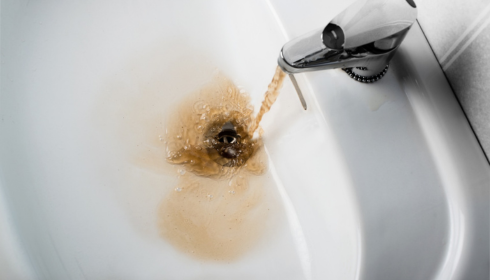Ever turn on your tap expecting crystal-clear water only to be greeted by a yellowish or brown tint that looks like weak tea? It’s not rust, and it’s not dirt—it’s usually tannin in water, an organic compound that’s surprisingly common in areas surrounded by vegetation or wetlands. While it’s harmless in most cases, tannin-stained water can be frustrating, especially when it starts tinting your laundry or leaving that faint “earthy” taste in your cup.
Let’s take a closer look at what tannins are, where they come from, and—most importantly—how you can get rid of them for good.
What Exactly Are Tannins?
Tannins are natural organic matter—basically, the byproduct of decaying leaves, roots, and vegetation that have seeped into groundwater or surface water. Think of them like the same compounds that give tea its color and wine its bitterness. When you draw water from a well near a swampy area, forest, or farmland, it’s easy for these organic acids to slip through the soil and dissolve into your water supply.
The result? A faint yellow to amber hue that can make your sink water look like someone brewed tea in it. Tannins don’t pose health risks, but their presence is annoying enough to make most homeowners want to do something about it.
The Signs You Might Have Tannins in Your Water
People usually spot tannins before they realize what’s happening. The signs can be subtle or dramatic depending on concentration. You might notice:
- A light yellow or brown tint in your water, especially in white sinks, tubs, or toilets.
- Laundry that comes out dingy or stained even after a full wash cycle.
- Water that has a faint earthy, musty, or tea-like taste.
- Coffee or tea that brews with an odd hue or flat flavor.
While it looks unpleasant, tannic water is rarely dangerous—it’s more of an aesthetic and comfort issue. Still, if you rely on well water, it’s smart to test it regularly to ensure no other contaminants (like iron or manganese) are piggybacking along.
What Causes Tannins to Enter Well Water?
Tannins don’t magically appear overnight. They’re typically found in shallow wells or aquifers close to surface water sources. Areas with peat soils, wetlands, or heavy vegetation see them more often. Rainwater can leach through decomposing organic matter, carrying these natural acids into groundwater systems.
It’s not unusual for two homes just a few miles apart to have totally different water quality—one with crystal-clear water and another battling that tea-colored tint daily. Local geology, well depth, and surrounding land conditions all play a part.
So, How Can You Fix It?
Here’s the good news: you don’t have to live with brown-tinted water forever. Knowing how to get rid of tannins in well water comes down to the right combination of testing and treatment.
Start by testing your water to confirm that tannins are indeed the culprit (and not iron, which can create similar discoloration). Once confirmed, you’ve got a few solid options:
- Anion exchange filters – These work similarly to water softeners but target negatively charged organic particles instead of calcium or magnesium. They’re one of the most effective ways to remove tannins.
- Activated carbon filters – Great for improving taste and reducing mild discoloration, though not always powerful enough on their own for high-tannin water.
- Oxidation and filtration systems – In some cases, oxidizing agents can help break down tannins for easier filtration.
- Reverse osmosis (RO) – Ideal for smaller applications like drinking water, RO can remove tannins along with other dissolved impurities.
For most homeowners, the best approach is a custom combination of these systems based on well water test results.
Why Location Matters — Especially in Brainerd, MN
If you’re dealing with tannin water treatment Brainerd MN you’re not alone. The region’s natural landscape—rich in lakes, forests, and wetlands—makes it especially prone to tannin contamination in private wells. Local water treatment specialists often design solutions tailored to this geography, considering factors like organic load, water pH, and iron levels.
Brainerd homeowners often find that a multi-stage treatment setup—like an anion exchange system paired with carbon polishing—works wonders. The goal isn’t just to make your water clear but to restore its taste, smell, and overall quality.
The Hidden Costs of Ignoring Tannins
While tannins might seem harmless, letting them linger too long can create subtle but annoying problems around the home. Your laundry starts to look off-white, fixtures develop brownish stains, and even your dishes might have that faint yellow hue. It’s one of those small things that slowly chips away at comfort until you finally decide enough is enough.
Worse, tannins can interfere with some other filtration systems by clogging resin beds or reducing filter efficiency. That’s why proper treatment isn’t just about aesthetics—it’s about keeping your entire water system running smoothly.
Maintenance Tips for Clearer Water
Once your filtration system is installed, maintenance is key. Replace filter media as recommended, check your resin bed for fouling, and keep an eye on water color changes. If the discoloration slowly creeps back, it might be time for regeneration or filter replacement.
You don’t need to obsess over it—just be consistent. Much like changing your car’s oil, routine upkeep saves you money and frustration down the road.
Wrapping It All Up
Water should be clear, odorless, and refreshing—not look like it came from a forest pond. Tannins are a natural nuisance, but they’re not invincible. Whether you live in Minnesota or anywhere else, understanding what’s causing the discoloration and investing in the right system can bring your water back to its best.
At the end of the day, treating tannin-stained well water isn’t about luxury—it’s about peace of mind. Because when you finally turn on your tap and see clear water again, you’ll realize just how much that simple clarity was worth.

